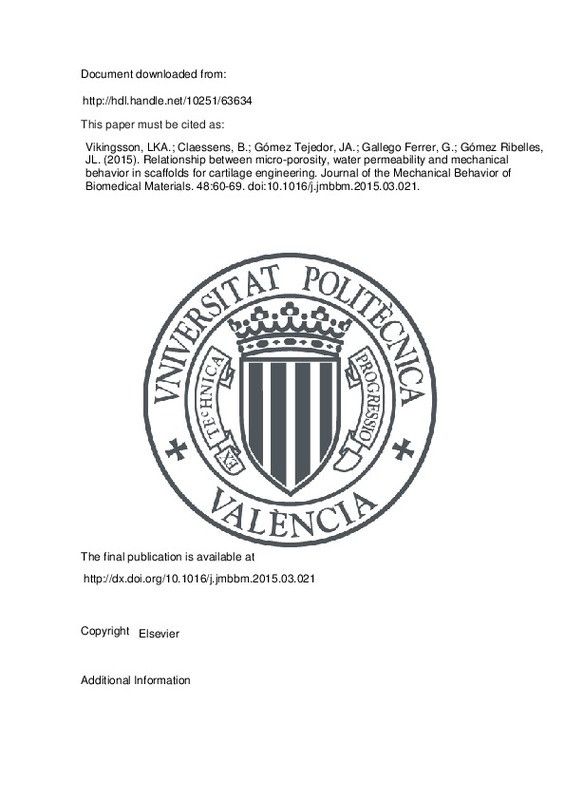JavaScript is disabled for your browser. Some features of this site may not work without it.
Buscar en RiuNet
Listar
Mi cuenta
Estadísticas
Ayuda RiuNet
Admin. UPV
Relationship between micro-porosity, water permeability and mechanical behavior in scaffolds for cartilage engineering
Mostrar el registro sencillo del ítem
Ficheros en el ítem
| dc.contributor.author | Vikingsson, Line Karina Alva
|
es_ES |
| dc.contributor.author | Claessens, B.
|
es_ES |
| dc.contributor.author | Gómez Tejedor, José Antonio
|
es_ES |
| dc.contributor.author | Gallego-Ferrer, Gloria
|
es_ES |
| dc.contributor.author | Gómez Ribelles, José Luís
|
es_ES |
| dc.date.accessioned | 2016-05-04T14:32:42Z | |
| dc.date.available | 2016-05-04T14:32:42Z | |
| dc.date.issued | 2015-08 | |
| dc.identifier.issn | 1751-6161 | |
| dc.identifier.uri | http://hdl.handle.net/10251/63634 | |
| dc.description.abstract | In tissue engineering the design and optimization of biodegradable polymeric scaffolds with a 3D-structure is an important field. The porous scaffold provide the cells with an adequate biomechanical environment that allows mechanotransduction signals for cell differentiation and the scaffolds also protect the cells from initial compressive loading. The scaffold have interconnected macro-pores that host the cells and newly formed tissue, while the pore walls should be micro-porous to transport nutrients and waste products. Polycaprolactone (PCL) scaffolds with a double micro- and macro-pore architecture have been proposed for cartilage regeneration. This work explores the influence of the micro-porosity of the pore walls on water permeability and scaffold compliance. A Poly(Vinyl Alcohol) with tailored mechanical properties has been used to simulate the growing cartilage tissue inside the scaffold pores. Unconfined and confined compression tests were performed to characterize both the water permeability and the mechanical response of scaffolds with varying size of micro-porosity while volume fraction of the macro-pores remains constant. The stress relaxation tests show that the stress response of the scaffold/ hydrogel construct is a synergic effect determined by the performance of the both components. This is interesting since it suggests that the in vivo outcome of the scaffold is not only dependent upon the material architecture but also the growing tissue inside the scaffold's pores. On the other hand, confined compression results show that compliance of the scaffold is mainly controlled by the micro-porosity of the scaffold and less by hydrogel density in the scaffold pores. These conclusions bring together valuable information for customizing the optimal scaffold and to predict the in vivo mechanical behavior. | es_ES |
| dc.description.sponsorship | The authors gratefully acknowledge the financial support from the Spanish Ministry of Economy and Competitiveness through the MAT2013-46467-C4-1-R project, including FEDER funds. CIBER-BBN is an initiative funded by the VI National R&D&I Plan 2008-2011, Iniciativa Ingenio 2010, Consolider Program, CIBER Actions and financed by the Instituto de Salud Carlos III with the assistance from the European Regional Development Fund. | en_EN |
| dc.language | Inglés | es_ES |
| dc.publisher | Elsevier | es_ES |
| dc.relation.ispartof | Journal of the Mechanical Behavior of Biomedical Materials | es_ES |
| dc.rights | Reconocimiento - No comercial - Sin obra derivada (by-nc-nd) | es_ES |
| dc.subject | Porous scaffolds | es_ES |
| dc.subject | Permeability | es_ES |
| dc.subject | Polycaprolactone | es_ES |
| dc.subject | Poly (vinyl alcohol) | es_ES |
| dc.subject | Freezing and thawing | es_ES |
| dc.subject | Mechanical properties | es_ES |
| dc.title | Relationship between micro-porosity, water permeability and mechanical behavior in scaffolds for cartilage engineering | es_ES |
| dc.type | Artículo | es_ES |
| dc.identifier.doi | 10.1016/j.jmbbm.2015.03.021 | |
| dc.relation.projectID | info:eu-repo/grantAgreement/MINECO//MAT2013-46467-C4-1-R/ES/ESTIMULACION MECANICA LOCAL DE CELULAS MESENQUIMALES DE CARA A SU DIFERENCIACION OSTEOGENICA Y CONDROGENICA EN MEDICINA REGENERATIVA/ | es_ES |
| dc.rights.accessRights | Abierto | es_ES |
| dc.contributor.affiliation | Universitat Politècnica de València. Centro de Biomateriales e Ingeniería Tisular - Centre de Biomaterials i Enginyeria Tissular | es_ES |
| dc.description.bibliographicCitation | Vikingsson, LKA.; Claessens, B.; Gómez Tejedor, JA.; Gallego-Ferrer, G.; Gómez Ribelles, JL. (2015). Relationship between micro-porosity, water permeability and mechanical behavior in scaffolds for cartilage engineering. Journal of the Mechanical Behavior of Biomedical Materials. 48:60-69. https://doi.org/10.1016/j.jmbbm.2015.03.021 | es_ES |
| dc.description.accrualMethod | S | es_ES |
| dc.relation.publisherversion | http://dx.doi.org/10.1016/j.jmbbm.2015.03.021 | es_ES |
| dc.description.upvformatpinicio | 60 | es_ES |
| dc.description.upvformatpfin | 69 | es_ES |
| dc.type.version | info:eu-repo/semantics/publishedVersion | es_ES |
| dc.description.volume | 48 | es_ES |
| dc.relation.senia | 292538 | es_ES |
| dc.identifier.eissn | 1878-0180 | |
| dc.contributor.funder | Ministerio de Economía y Competitividad | es_ES |
| dc.contributor.funder | Ministerio de Ciencia e Innovación | es_ES |
| dc.contributor.funder | European Regional Development Fund | es_ES |
| dc.contributor.funder | Instituto de Salud Carlos III | es_ES |







![[Cerrado]](/themes/UPV/images/candado.png)

